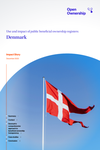Use and impact of public beneficial ownership registers: Denmark
Help us understand how you are making use of resources from the Open Ownership website by filling out this short survey
Publication type
Case study
Publication
Country focus
Denmark
Sections
Impact,
Implementation,
Research
Summary
Denmark was one of the first countries to implement a public beneficial ownership (BO) register in 2017, facilitating the use of BO data by a range of actors. This impact story shows how effective beneficial ownership transparency (BOT) reforms in the country have helped government, private sector, and civil society actors advance domestic policy objectives. It documents measures that have been taken to increase levels of compliance; establish digital approaches to ensure the accuracy of information; and ensure information is accessible and available in a number of ways, including through an application programming interface (API).
The impact story describes how these measures enable BO data use. For example, corporate data service providers play a central role in Denmark’s information ecosystem. Many of them use the API provided by the Danish Business Authority to ingest beneficial ownership information (BOI) into various software products, platforms, and tools, and combine it with other data sources to maximise its usability and provide new analytical insights. The story also highlights key challenges raised by Danish data users. One is the lack of access to structured BOI from other jurisdictions. Both journalists and private sector users in Denmark state that connecting domestic BOI with data from other jurisdictions would save considerable time and resources.
Key points
- Denmark’s BOT reforms followed a series of national scandals exposing how corporate vehicles were used to launder hundreds of billions of Danish kroner increased public awareness of the role of corporate opacity and changing EU anti-money laundering requirements.
- Denmark implemented the fourth EU Anti-money Laundering Directive with Act No. 262 of 16 March 2016, and went beyond it by allowing access to BOI on the Central Business Register (CVR) by the public.
- Some of the hallmarks of Denmark’s comprehensive approach to BOT implementation are the high compliance rate it has achieved through clear guidance and dissuasive sanctions (96% as of 2019); the inclusion of legal entities and arrangements in a single register; and the use of digital strategies to increase data accuracy and usability.
- Data use case studies show how effective BOT reforms can help an ecosystem of users advance domestic policy objectives. They highlight how non-government users such as business journalists and corporate service providers are a critical part of this ecosystem, and how both government and regulated entities rely on these users.
- These user stories should be front and centre in informing what access to BOI should look like in the future, as governments, businesses, and civil society are pushed to think about how to better strike the balance between privacy, data protection, and transparency.
- Due to the transnational nature of financial crime, effective implementation in more jurisdictions, and the ability to combine information from different national BO registers and other datasets, is a key demand from Danish data users.
